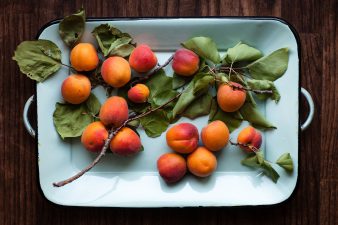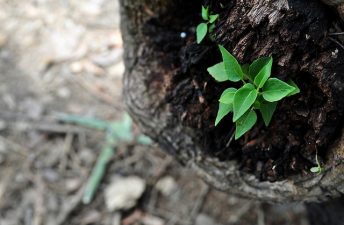Finding bones at an archeology site reveals the kind of animals our human ancestors would eat. But plants? Remains in the kitchens and pots of our ancients and their plant matter is much more elusive because plant remains disintegrate over time.
But scientists from the University of Bristol and Goethe University have uncovered the first insights into the origins of plant-based cuisine, locked inside pottery fragments dating back some 3,500 years ago from West Africa.
West African cuisine has long been known for its distinct ingredients and flavours, often enhanced by the addition of a large and diverse range of plant foods. But where did those plants come from? Are they from the past or are they a modern adaptation to our tastes?
A traditional meal in West Africa comprises a starchy staple cooked in a pot, served with a sauce prepared from vegetables, fish or meat, often accompanied by pulses.
These starchy staples include root crops such as yams, cassava, sorghum, pearl millet and maize. In the northern Sahel and savanna zones, pearl millet is mainly prepared as porridge, while in the southern forest zone, a pounded mash from tuber crops such as yam, called fufu, is the major starch-rich element.
Traditional cuisine couldn’t be traced back into time, until now
Indigenous vegetables, eaten at almost every West African meal, include eggplant, pumpkin and watermelon, okra (used as a thickener for soups and stews), as well as a staggering variety of both farmed and foraged green leafy vegetables, little known or used outside of the African continent.
These include leaves from the amaranth, roselle and baobab tree. However, investigating the origin of vegetables and leafy greens is difficult as they do not generally survive over archaeological timescales.
The science team carried out chemical analysis of more than 450 prehistoric potsherds from the Central Nigerian Nok culture to investigate what foods they were cooking in their pots. The Nok people are known for their remarkable large-scale terracotta figurines and early iron production in West Africa, around the first millennium BC.
Acidic soils at Nok archaeological sites meant that organic remains such as animal bones and plant remains did not survive very well so what Nok people were eating was somewhat of a mystery.
Looking at the far remains from plants, or the lipid bioprofile
“Charred plant remains like seeds and nutshells preserved in the archaeological sediments reflect only one part of what people consumed in the past,” stated Professor Katharina Neumann from Goethe University, who directed archaeobotanical research on the Nok Project: “We hoped that chemical analyses would provide additional insights into food preparation.”
The team’s results tie in well with ancient plant remains from the site which mainly comprise pearl millet but also cowpea and African peach.
Whilst there are few unique lipid biomarkers for leafy plants and cereals and, as such, specific plants consumed by the Nok people, or processed for medicinal purposes, cannot be identified, the results suggest that much of Nok plant consumption included leafy vegetables or ‘greens’, mirroring that of groups living in West Africa today, where these play a significant role in people’s diet.
It seems likely that Nok people consumed ‘greens’ or leaves from plants such as jute mallow, African eggplant, okra, cowpea and bombax, widely used today. These provide cheap but quality nutrition and add taste and flavour to the otherwise monotonous starch-based staples consumed and can be kept dried and stored for use throughout the year, affording a buffer in periods of food shortage.
One of the most important leaf-providing species is the baobab, which, together with species such as okra (Abelmoschus esculentus), false sesame, jute mallow and black sesame are today cooked in soups with a little potash (potassium carbonate) to give a high mucilage content or what is known as a ‘slimy’ consistency.
This soup is common in high yam producing areas, likely because pounded yam is known to be complemented by sauces of ‘slimy’ consistency as are other local cereal and tuber dishes.
Evidence for the use of leafy plants can also be found in ethnographic accounts. One of the earliest known mentions of baobab was by Al Bakri in Ghana, writing in 1068, in his great work ‘Kitāb al-Masālik wa-al-Mamālik’ (Book of Highways and of Kingdoms).
Jute mallow is mentioned by the Arab historian al-Umarī (1300 – 1349) and later, in the 19th century, Nachtigal, the German explorer, notes that it is used to prepare sauces to add to farinaceous foods in Chad and Mali. Nachtigal also writes of sauces made from leaves of herbs or trees, mentioning baobab leaves, added with fresh or dried meat, to porridges.
The possible preparation of tubers such as yam, in Nok pots also suggests a long history of use, in good agreement with evidence which suggests a domestication of yams in West Africa at around 2500 BC.
In summary, our results demonstrate that prehistoric plant processing and consumption in West Africa involved much more than the cooking of starchy food, the scientists report:
“It has allowed us to go beyond the identification of meals thought to consist mainly of meat and starchy plants. We can now confirm, based on the highly diverse range of lipid profiles presented here, the preparation of ancient meals combining vegetables, pulses, USOs and, possibly, herbs/spices,” the added.
Care about Aftrica? Read about the Great Green Wall progress.




